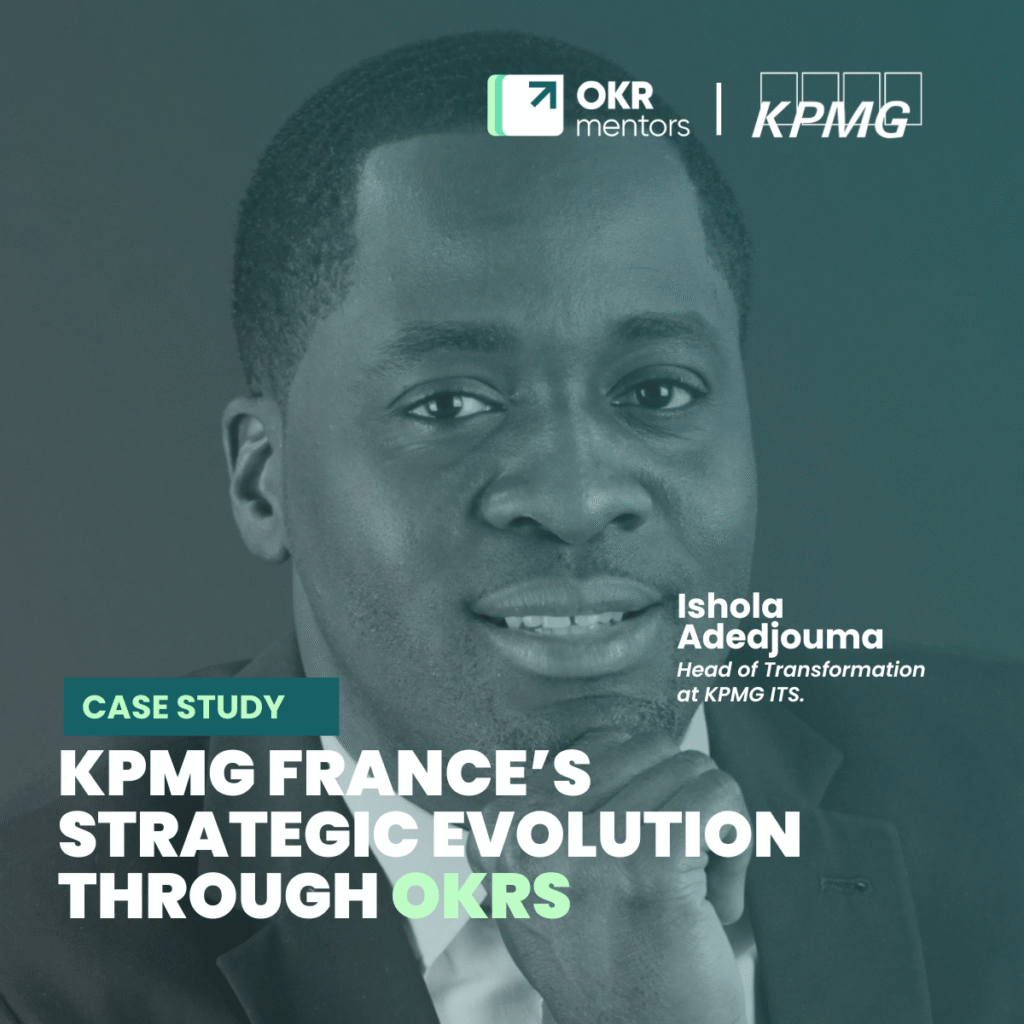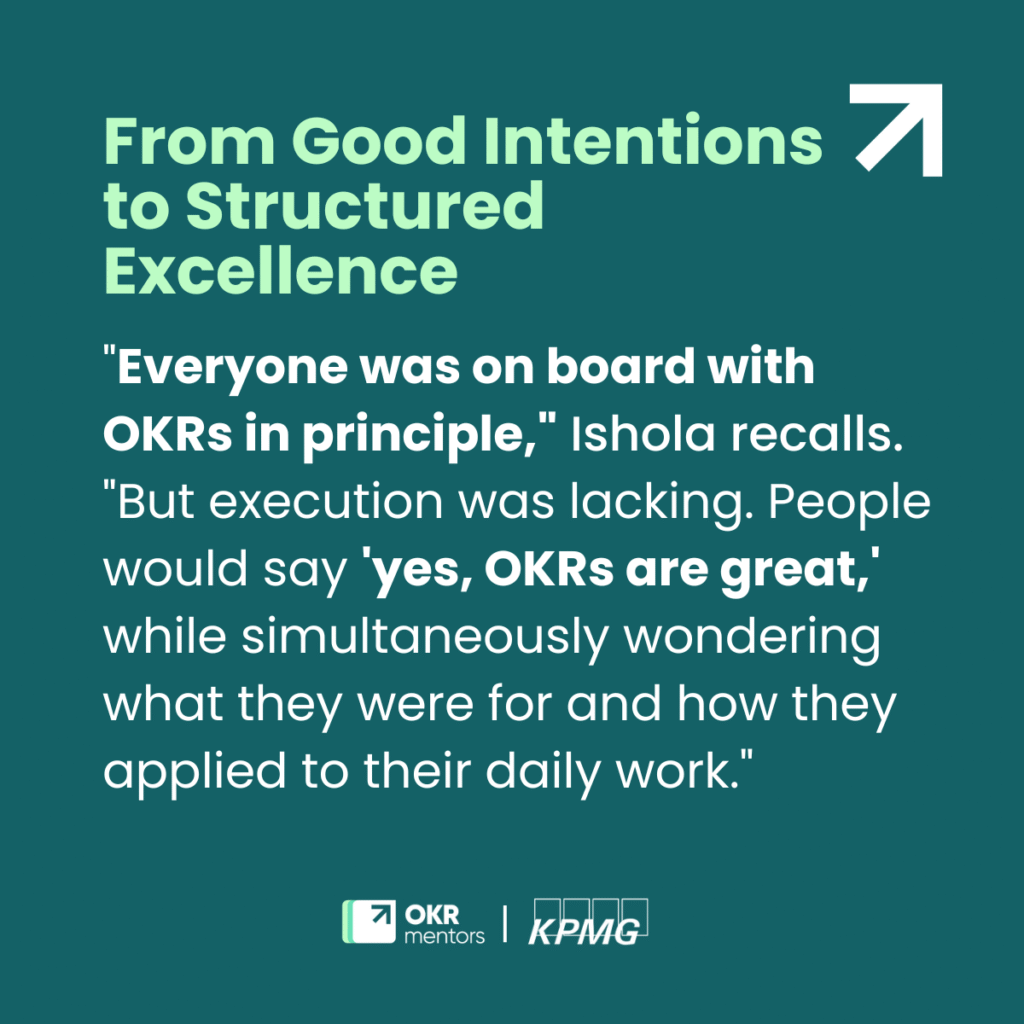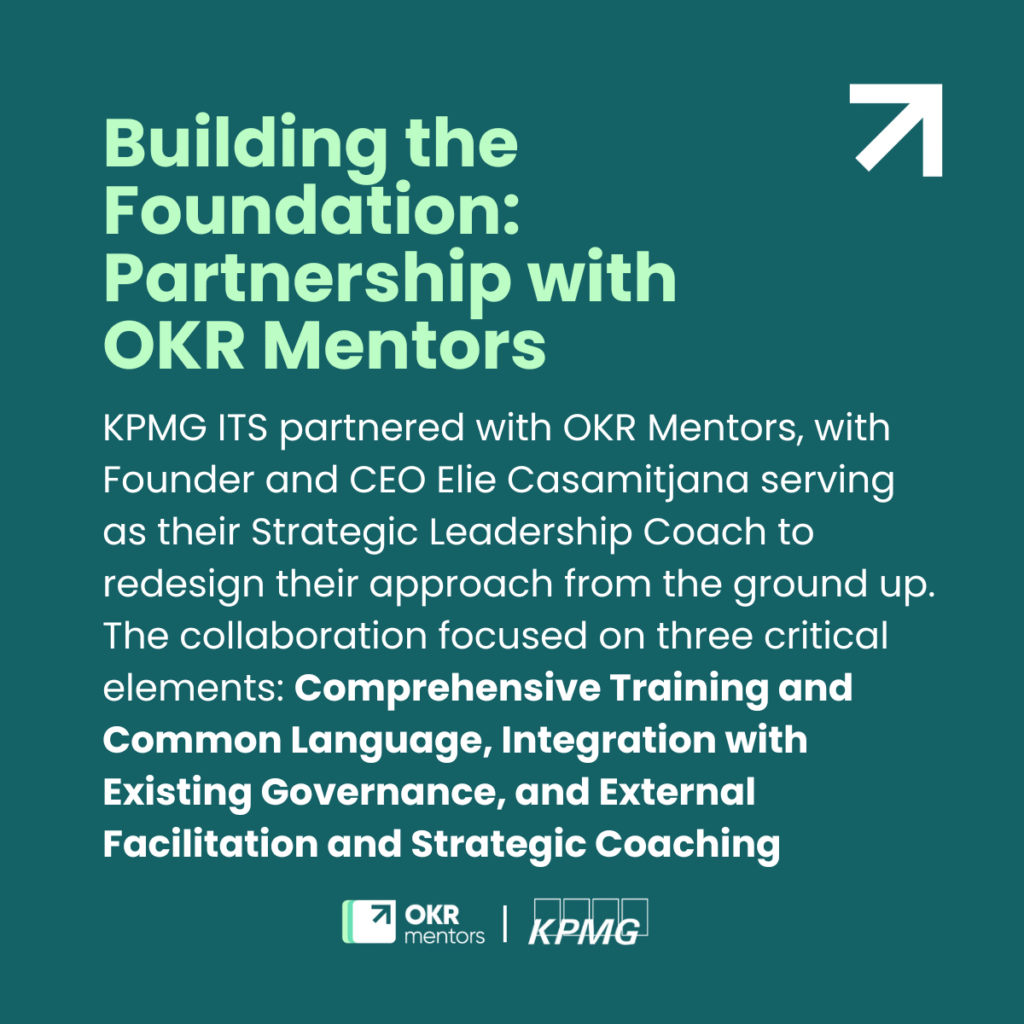When KPMG France’s Information Technology Services (ITS) division faced the challenge of moving from a task-driven culture to a value-driven partnership model, they turned to Objectives and Key Results (OKRs) as their transformation catalyst. What started as an 18-month journey of discovery has evolved into a fundamental shift in how this technology organization operates, collaborates, and delivers value to its business partners.
The Transformation Imperative
KPMG ITS serves as the technology backbone for KPMG France, supporting audit, advisory, accounting, and legal services across the firm. Yet despite their critical role, ITS leadership recognized two fundamental challenges that needed addressing.
“We identified two main challenges,” explains Ishola Adedjouma, Head of Transformation at KPMG ITS. “First was efficiency – we needed to move beyond quick wins to find deeper improvement opportunities. Second, and perhaps more important, was our positioning. We wanted to shift from being seen as just service providers to becoming true strategic partners who help shape business strategy.”
This desire to evolve from order-takers to strategic contributors became the driving force behind their OKR journey. The leadership team sought a framework that would not only improve performance but fundamentally change how teams thought about and communicated their work.

From Good Intentions to Structured Excellence
KPMG’s OKR story began with enthusiasm but quickly revealed the complexity of organizational transformation. The initial attempt, while well-intentioned, struggled with common pitfalls.
“Everyone was on board with OKRs in principle,” Ishola recalls. “But execution was lacking. People would say ‘yes, OKRs are great,’ while simultaneously wondering what they were for and how they applied to their daily work.”
The organization found itself tracking about fifty Key Results with zero effectiveness. Teams defaulted to activity-based metrics rather than outcome-focused measurements. Most critically, the lack of a common vocabulary around objectives meant conversations remained stuck at the task level rather than elevating to strategic outcomes.
Recognizing these challenges, KPMG ITS made a pivotal decision: bring in external expertise to guide their transformation properly.

Building the Foundation: Partnership with OKR Mentors
KPMG ITS partnered with OKR Mentors, with Founder and CEO Elie Casamitjana serving as their Strategic Leadership Coach to redesign their approach from the ground up. The collaboration focused on three critical elements:
1. Comprehensive Training and Common Language “The training was fundamental – absolutely key,” emphasizes Ishola. “Not just any training, but good training with contextual examples and practical exercises. Today, when we talk about moonshots or Key Results, everyone knows exactly what we mean.”
2. Integration with Existing Governance Rather than disrupting established rhythms, Elie Casamitjana worked with the team to carefully integrate OKRs into KPMG’s existing governance structure and selected KPMG KR monitoring tool. Weekly check-ins were merged with leadership meetings, creating a natural cadence for strategic discussions without adding bureaucratic overhead.
3. External Facilitation and Strategic Coaching Having Elie as their Strategic Leadership Coach proved invaluable for navigating organizational dynamics. “The external perspective has several virtues in our context,” notes Ishola. “Someone embedded in the organization can’t always spot all the warning signs or challenge established patterns effectively.”

Tangible Transformations: From Tasks to Outcomes
After implementing the new approach with their Strategic Leadership Coach for several months, KPMG ITS began seeing significant shifts in how teams operated:
Strategic Conversations Replace Task Updates “The first major improvement is that we now have discussions around objectives, not just task completion,” Ishola explains. “Previously, even at the leadership level, conversations focused on ‘I need to do this, I’m at this stage, I’m blocked here.’ Now we shine a spotlight on the objective we want to achieve, why we’re doing it, and how we measure success.”
Cross-Functional Alignment Accelerates OKRs created a shared language for prioritization across departments. When contributors understand the strategic objective behind requests, they can allocate resources more effectively with suitable priority and even propose innovative solutions beyond their immediate task.
“I’ve seen situations where we’ve reallocated people from other teams who were busy but could prioritize differently once they understood our quarterly obsessions,” shares Ishola.
Leadership Engagement Deepens The integration of OKR check-ins with existing leadership meetings transformed routine updates into strategic alignment sessions. “Before, we knew we needed to talk but often discussions weren’t systematically on priority subjects. Now, top-prioritised topics are there, and we sometimes don’t have enough time. It’s much better to have meaningful content than to stare at each other wondering what to discuss.”
Key Success Factors and Learnings
Through their 18-month journey working with their Strategic Leadership Coach, KPMG ITS identified several critical success factors:
1. Invest in Proper Training “Don’t assume a 30-minute internet tutorial will suffice,” warns Ishola. “You need comprehensive training with contextual examples that anchor the concepts.”
2. Secure Expert Guidance “Work with someone truly experienced in the state of the art – not someone who’s done OKRs for six months, but someone with multiple case studies who can propose the right tools for complex situations.”
3. Adapt to Organizational Context “Integration with existing processes is crucial. We skillfully integrated OKRs upstream of our roadmap planning without disrupting it. Take time to explain how OKRs complement rather than compete with existing frameworks.”
4. Maintain Momentum “Even now, as we’re seeing positive results, if we stopped the coaching and rhythm, we’d quickly fall back into old habits. Building automaticity takes time and consistent reinforcement. Changes have to be anchored as per Kotter 8th change model steps.”

The Road Ahead: Scaling Impact
KPMG ITS’s OKR journey continues to evolve with ongoing support from Elie Casamitjana and the OKR Mentors team. Having established a solid foundation at the leadership level, the organization is now planning its next phase of expansion.
“In six months, we’ll begin taking OKRs to pilot teams throughout the organization,” Ishola explains. “The goal is to have most teams operating under this approach, with potentially one or two internal OKR coaches supporting multiple domains.”
The success is already generating interest across KPMG France. The quarterly “Carnet de Bord” – a strategic update distributed to the executive committee – now explicitly references OKRs as the framework for tracking strategic initiatives.
“Once we communicate at this level, there’s no turning back on OKRs,” notes Ishola. “We’re establishing ourselves as the model for how strategic execution should work across KPMG.”
A Partnership Built for the Long Term
The collaboration between KPMG ITS and OKR Mentors exemplifies how strategic leadership coaching and training can accelerate internal transformation. The combination of structured methodology, adaptive coaching, and deep organizational understanding created the conditions for sustainable change.
“Two things attracted me to OKR Mentors’ approach,” reflects Ishola. “First, the proven methodology that could flex to our context. Second, the soft skills – understanding how to navigate our environment, when to push and when to pull, without losing sight of the objective.”
As KPMG ITS continues its transformation from service provider to strategic partner, OKRs have become the common language that enables this evolution. By focusing on outcomes rather than activities, fostering cross-functional collaboration, and maintaining disciplined execution rhythms with their Strategic Leadership Coach, they’ve created a blueprint for technology organizations seeking to increase their strategic impact.
The journey from about fifty unfocused Key Results to aligned strategic objectives demonstrates that with the right approach, commitment, and strategic leadership coaching from experienced partners like OKR Mentors, even large, complex organizations can transform how they define and deliver value.


